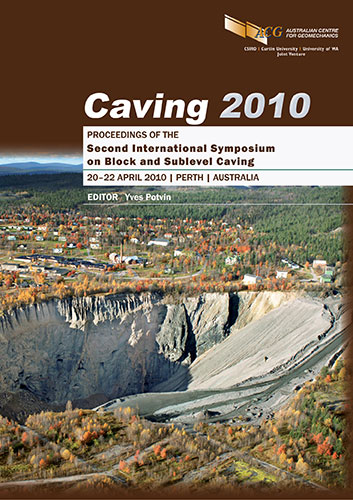Estimation of rock mass changes induced by hydraulic fracturing and cave mining by double difference passive tomography

|
Authors: Pfitzner, MJ; Westman, E; Morgan, M; Finn, D; Beck, DA Paper is not available for download Contact Us |
DOI https://doi.org/10.36487/ACG_rep/1002_47_Pfitzner
Cite As:
Pfitzner, MJ, Westman, E, Morgan, M, Finn, D & Beck, DA 2010, 'Estimation of rock mass changes induced by hydraulic fracturing and cave mining by double difference passive tomography', in Y Potvin (ed.), Caving 2010: Proceedings of the Second International Symposium on Block and Sublevel Caving, Australian Centre for Geomechanics, Perth, pp. 677-684, https://doi.org/10.36487/ACG_rep/1002_47_Pfitzner
Abstract:
Double difference (DD) passive seismic tomography was employed at the Ridgeway Deeps block cave project to identify the magnitude and extent of preconditioning due to hydraulic fracturing and to identify zones of damage and increased stress during the undercutting and early stages of caving. This was done by identifying zones of decreased seismic velocity over the period corresponding to the preconditioning project and cave initiation. The data obtained was used in parallel with numerical model calibration studies to improve understanding of the relationship between velocity changes, stress and damage and also to quantify the effectiveness of a preconditioning campaign. The approach was able to quantify the induced changes successfully, but there were a number of learning points for future projects. The technique is seen as an important analysis tool that can be used to leverage significant additional value from existing seismic systems and data sets.
References:
Duplancic, P. (2001) Characterisation of caving mechanisms through analysis of stress and seismicity, Unpublished PhD Thesis, Department of Civil and Resource Engineering, University of Western Australia, 227 p.
Glazer, S.N. (2007) Applications of mine seismology methods in block cave mining, in Proceedings First International Symposium on Block and Sub-Level Caving, T.R. Stacey (ed), Southern African Institute of Mining and Metallurgy, Cape Town, South Africa, pp. 281–302.
Hudyma, M., Potvin, Y. and Allison, D. (2007) Seismic monitoring of the Northparkes Lift 2 block cave, Parts I and II, in Proceedings First International Symposium on Block and Sub-Level Caving, T.R. Stacey (ed), Southern African Institute of Mining and Metallurgy, Cape Town, South Africa, pp. 303–354.
Lynch, R.A. and Lötter, E.C. (2007) Estimation of cave geometry using a constrained velocity model inversion with passive seismic data, in Proceedings First International Symposium on Block and Sub-Level Caving, T.R. Stacey (ed), Southern African Institute of Mining and Metallurgy, Cape Town, South Africa, pp. 355–368.
Morgan, M. (2009) Ridgeway Deeps hydraulic fracture application report, unpublished internal report, Newcrest Mining Limited.
Pankow, K., McCarter, M. and Arabasz, W. (2008) Coal-mining-induced seismicity in Utah – Improving spatial resolution using double-difference relocations, in Proceedings 27th International Conference on Ground Control in Mining, Morgantown, West Virginia, July 2008, Morgantown, West Virginia University, USA, pp. 91–97.
Pfitzner, M.J. (2003) Monitoring a blind sublevel cave – A case study of an integrated approach at Newcrest Mining’s Ridgeway Gold Mine, in Proceedings First Australasian Ground Control in Mining Conference, Ground Control in Mining; Technology and Practice, B.K. Hebbelwhite (ed), University of New South Wales, Australia,
pp. 113–122.
Trifu, C.I., Shumila, V. and Burgio, N. (2002) Characterisation of the caving front at Ridgeway Mine, New South Wales, based on geomechanical data and detailed microseismic analysis, in Proceedings International Seminar on Deep and High Stress Mining, Australian Centre for Geomechanics, Perth, Australia, Section 41.
Waldhauser, F. and Ellsworth, W.L. (2000) A double-difference earthquake location algorithm: Method and application to the northern Hayward fault, Bulletin of the Seismological Society of America, Vol. 90, pp. 1353–1368.
Zhang, H. and Thurber, C. (2006) Development and applications of double-difference seismic tomography, Birkhauser Verlag, Basel, Pure and Applied Geophysics, Vol. 163, pp. 373–403.
© Copyright 2025, Australian Centre for Geomechanics (ACG), The University of Western Australia. All rights reserved.
View copyright/legal information
Please direct any queries or error reports to repository-acg@uwa.edu.au
View copyright/legal information
Please direct any queries or error reports to repository-acg@uwa.edu.au